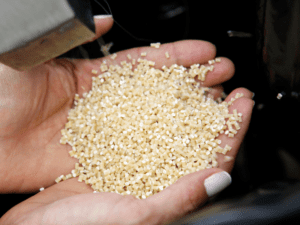Environmental issues in the plastic industry are a hot topic, however the terminology used can be confusing and sometimes used misleadingly. Below we take a look at some of the most popular phrases in our green glossary for plastics, their environmental impact, and what they really mean.
Recycled Plastics

The reprocessing of plastic waste into new material and products. Recycled plastic can be entirely made from previously used plastic; or made from a percentage of recycled material and the remainder made from virgin material. The most commonly recycled plastics are PET, HDPE and PP – all of which are found in many products in our homes.
Bioplastics
Bioplastics are plastic materials derived from at least some if not all renewable biological sources. These are typically starches, proteins, vegetable fats or oils. Bioplastics break down (more of that later) at different rates depending on their base material, wall thickness and environmental conditions. Some bioplastics degrade completely- leaving only water, carbon dioxide and biomass. Others, which are not entirely biomass based, degrade into smaller plastic pellets.
Traditional plastics are derived from fossil fuels which are not only finite resources, but they also generate more carbon emissions and do not break down naturally (to carbon dioxide, water etc.) causing harm to our environment and wildlife.
Compostable Plastics
-At home
Certain bioplastics (including some in the BEC range) are defined as compostable at home. This means what it says on the tin really- they can be composted either in a compost heap or simply when placed into soil and will degrade into natural elements.
These plastics must adhere to certain specifications (EN13432) to be compostable in a home environment, due to the lower temperatures and longer time needed than in an industrial composting setting.
-Industrially
Industrially compostable plastics are sent to specialist facilities which heat the bioplastic to a temperature that encourages microbes to break it down. These facilities get far hotter than a typical domestic compost heap. Industrial compostability must be confirmed to international standards.
Degradable
Another vague phrase which many take to mean the same as biodegradable, this is not the case. For a plastic to be degradable it simply needs to break down… if only into smaller pieces of plastic. Some additives that can be mixed into the plastic help it to break down in oxygen or sunlight. Typically though, they become microplastics.
Plastics degrade at massively variable rates depending upon their origin, size and the conditions they are degrading in.
Biodegradable
Plastics designed to break down when exposed to microorganisms are defined as biodegradable. Often these are also bioplastics made from biomass of some type, and biodegrade into water, carbon dioxide and some biomass. This release of carbon dioxide is far better for the environment that the release of methane from typical landfill.
Bio-sourced
A bio-sourced plastic is the same as a bioplastic- one made from at least part organic material. Typically this is derived from carbohydrates, proteins or cellulose. Bio-sourced polymers are not always biodegradable.
Sustainability
Sustainability is a complex topic in the world of plastics, covering environmental, economic, and social factors. Environmental sustainability covers the environmental impact of producing, using and disposing/recycling of plastics. Economic sustainability concerns how viable plastic is financially as a material across its lifespan. Social sustainability concerns the jobs plastic manufacturing creates, and the medical and safety aspects of our lives that plastic contributes positively to.
Want to know more about sustainability in plastics or BEC’s bioplastic range? Get in touch via hello@becgroup.com or call 01425 613131


